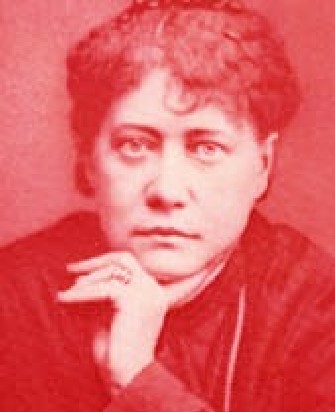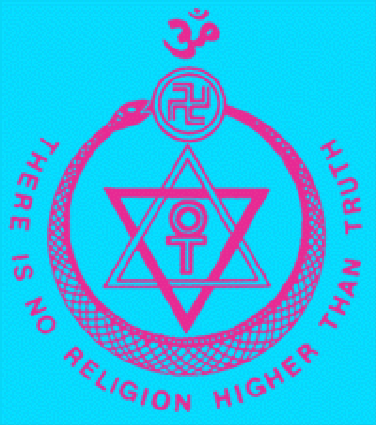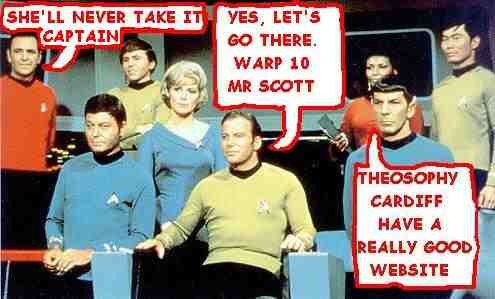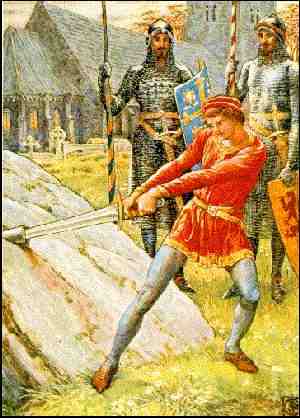Writings
of H P Blavatsky
Theosophy
House
206
Newport Road, Cardiff, Wales, UK. CF24 -1DL

Helena Petrovna Blavatsky (1831 – 1891)
The Founder of Modern Theosophy
Elementaries
By
H
P Blavatsky
[From The
Religio-Philosophical Journal,
I PERCEIVE that
of late the ostracized subject of the Kabalistic "Elementaries" is
beginning to appear in the orthodox spiritualistic papers pretty often. No
wonder; Spiritualism and its Philosophy are progressing, and they will progress
despite the opposition of some very learned ignoramuses, who imagine the Cosmos
rotates within the academic brain. But if a new term is once admitted for
discussion, the least we can do is to first clearly ascertain what that term
means. We students of the Oriental Philosophy count it a clear gain that
spiritualistic journals on both sides of the Atlantic are beginning to discuss
the subject of sub-human and earth-bound beings, even though they ridicule the
idea. But do those who ridicule know what they are talking about, having never
studied the Kabalistic writers? It is evident to me that they are confounding
the "Elementaries"—disembodied, vicious, and earth-bound, yet human
Spirits—with the "Elementals," or Nature Spirits.
With your
permission, then, I will answer an article by Dr. Woldrich which appeared in
your Journal of the 27th inst., and to which the author gives the title of
"Elementaries." I freely admit that, owing to my imperfect knowledge
of English at the time I first wrote upon the Elementaries, I may have myself
contributed to the present confusion, and thus brought upon my doomed head the
wrath of Spiritualists, mediums, and their "guides" into the bargain.
But now I will attempt to make my meaning clear. Éliphas Lévi applies the term
" Elementary" equally to earth-bound human Spirits and to the creatures
of the elements. This carelessness on his part is due to the fact that as the
human Elementaries are considered by the Kabalists as having irretrievably lost
every chance of immortality, they therefore, after a certain period of time,
become no better than the "Elementals," who never had any souls at
all. To disentangle the subject, I have, in my
Dr. Woldrich,
in imitation of Herbert Spencer, attempts to explain the existence of a popular
belief in Nature Spirits, demons and mythological deities, as the effect of an
imagination untutored by Science, and wrought upon by misunderstood natural
phenomena. He attributes the legendary Sylphs, Undines, Salamanders and
Gnomes—four great families, which include numberless sub-divisions—to mere
fancy; going however to the extreme of affirming that by long practice one can
acquire
That power
which disembodied spirits have of materializing apparitions by the will.
Granted that
"disembodied Spirits" have sometimes that power; but if disembodied
why not embodied Spirits also, i.e., a yet living person who has become an
Adept in Occultism through study? According to Dr. Woldrich’s theory, an
embodied Spirit or Magician can create only subjectively, or to quote his
words:
He is in the
habit of summoning, that is, bringing up to his imagination, his familiar
spirits, which, having responded to his will, he considers as real existences.
I will not stop
to enquire for the proofs of this assertion, for it would only lead to an
endless discussion. If many thousands of Spiritualists in Europe and America
have seen materialized objective forms which assure them they were the Spirits
of once living persons, millions of Eastern people throughout the past ages
have seen the Hierophants of the Temples, and even now see them in India,
without being in the least mediums, also evoking objective and tangible forms,
which display no pretensions to being the souls of disembodied men. But I will
only remark that, though subjective and invisible to others, as Dr. Woldrich
tells us, these forms are palpable, hence objective to the clairvoyant; no
scientist has yet mastered the mysteries of even the physical sciences
sufficiently to enable him to contradict, with anything like plausible or
incontrovertible proofs, the assumption that because the clairvoyant sees a
form remaining subjective to others, this form is nevertheless neither a
"hallucination" nor a fiction of the imagination. Were the persons
present endowed with the same clairvoyant faculty, they would every one of them
see this creature of "hallucination" as well; hence there would be
sufficient proof that it had an objective existence. And this is how the
experiments are conducted in certain psychological training schools, as I call
such establishments in the East. One clairvoyant is never trusted. The person
may be honest, truthful, and have the greatest desire to learn only that which
is real, and yet mix the truth unconsciously and accept an Elemental for a
disembodied Spirit, and vice versâ. For instance, what guarantee can Dr.
Woldrich give us that "Hoki" and "Thalla," the guides of
Miss May Shaw, were not simply creatures produced by the power of the
imagination? This gentleman may have the word of his clairvoyant for this; he
may implicitly and very deservedly trust her honesty when in her normal state;
but the fact alone that a medium is a passive and docile instrument in the
hands of some invisible and mysterious powers, ought to make her irresponsible
in the eves of every serious investigator. It is the Spirit, or these invisible
powers, he has to test, not the clairvoyant; and what proof has he of their
trustworthiness that he should think himself warranted in coming out as the
opponent of a Philosophy based on thousands of years of practical experience,
the iconoclast of experiments performed by whole generations of learned
Egyptians, Hierophants, Gurus, Brâhmans, Adepts of the Sanctuaries, and a whole
host of more or less learned Kabalists, who were all trained Seers? Such an
accusation, moreover, is dangerous ground for the Spiritualists themselves.
Admit once that a Magician creates his forms only in fancy, and as a result of
hallucination, and what becomes of all the guides, spirit friends and the tutti
quanti from the sweet "
From the
standpoint of certain Buddhist Schools, your correspondent may be right. Their
Philosophy teaches that even our visible Universe assumed an objective form as
a result of the fancy followed by the volition or the will of the Unknown and
Supreme Adept, differing, however, from Christian theology, inasmuch as they
teach that instead of calling out our Universe from nothingness, He had to
exercise His will upon preëxisting Matter, eternal and indestructible as to
invisible Substance, though temporary and ever-changing as to forms. Some
higher and still more subtle metaphysical Schools of Nepaul even go so far as
to affirm—on very reasonable grounds, too—that this preexisting and
self-existent Substance or Matter (Svabhâvat) is itself without any other
creator or ruler; when in the state of activity it is Pravritti, a universal
creating principle; when latent and passive they call this force Nirvritti. As
for something eternal and infinite, for that which had neither beginning nor
end there can be neither past nor future, but everything that was and will be,
IS; therefore there never was an action or even thought, however simple, that
is not impressed in imperishable records on this Substance, called by the
Buddhists Svabhâvat, by the Kabalists Astral Light. As in a faithful mirror,
this Light reflects every image, and no human imagination could see anything
outside that which exists impressed somewhere on the eternal Substance. To
imagine that a human brain can conceive of anything that was never conceived of
before by the "universal brain," is a fallacy and a conceited
presumption. At best, the former can catch now and then stray glimpses of the
"Eternal Thought" after this has assumed some objective form, either
in the world of the invisible, or visible, Universe. Hence the unanimous
testimony of trained Seers goes to prove that there are such creatures as the
Elementals; and that though the Elementaries have been at some time human
Spirits, they, having lost every connection with the purer immortal world, must
be recognized by some special term which would draw a distinct line of
demarcation between them and the true and genuine disembodied souls, which have
henceforth to remain immortal. To the Kabalists and the Adepts, especially in
Spiritualists
have never accepted the suggestion and sound advice of certain of their seers
and mediums. They have regarded Dr. Peebles’ "Gadarenes" with
indifference; they have shrugged their shoulders at the "Rosicrucian"
fantasies of P. B. Randolph, and his Ravalette has made none of them the wiser;
they have frowned and grumbled at A. Jackson Davis’ "Diakka"; and
finally, lifting high the banner, have declared a murderous war of
extermination against the Theosophists and Kabalists. What are now the results?
A series of
exposures of fraudulent mediums that have brought mortification to their
endorsers and dishonour upon the cause; identification by genuine seers and
mediums of pretended Spirit-forms that were afterwards found to be mere
personations by lying cheats, go to prove that in such instances at least,
outside of clear cases of confederacy, the identifications were due to illusion
on the part of the said seers; spirit-babes discovered to be battered masks and
bundles of rags; obsessed mediums driven by their guides to drunkenness and
immortality of conduct; the practices of free-love endorsed and even prompted
by alleged immortal Spirits; sensitive believers forced to the commission of
murder, suicide, forgery, embezzlement and other crimes; the over-credulous led
to waste their substance in foolish investments and the search after hidden
treasures; mediums fostering ruinous speculations in stocks; free-loveites
parted from their wives in search of other female affinities; two continents
flooded with the vilest slanders, spoken and sometimes printed by mediums
against other mediums; incubi and succubi entertained as returning
angel-husbands or wives; mountebanks and jugglers protected by scientists and
the clergy, and gathering large audiences to witness imitations of the
phenomena of cabinets, the reality of which genuine mediums themselves and
Spirits are powerless to vindicate by giving the necessary test conditions;
séances still held in Stygian darkness, where even genuine phenomena can
readily be mistaken for the false, and false for the real; mediums left
helpless by their angel guides, tried, convicted, and sent to prison, and no
attempt made to save them from their fate by those who, if they are Spirits
having the power of controlling mortal affairs, ought to have enlisted the
sympathy of the heavenly hosts on behalf of their mediums in the face of such
crying injustice; other faithful spiritualistic lecturers and mediums broken
down in health and left unsupported by those calling themselves their patrons
and protectors—such are some of the features of the present situation; the
black spots of what ought to become the grandest and noblest of all religious
Philosophies freely thrown by the unbelievers and Materialists into the teeth
of every Spiritualist. No intelligent person of the latter class need go
outside of his own personal experience to find examples like the above.
Spiritualism has not progressed and is not progressing and will not progress,
until its facts are viewed in the light of the Oriental Philosophy.
Thus, Mr.
Editor, your esteemed correspondent, Dr. Woldrich, may be found guilty of an
erroneous proposition. In the concluding sentence of his article he says:
I know not whether
I have succeeded in proving the Elementary a myth, but at least I hope that I
have thrown some more light upon the subject to some of the readers of the
journal.
To this I would
answer: (1) He has not proved at all the "Elementary a myth," since the
Elementaries are, with a few exceptions, the earth-bound guides and Spirits in
which he believes, together with every other Spiritualist. (2) Instead of
throwing light upon the subject, the Doctor has but darkened it the more. (3)
Such explanations and careless exposures do the greatest harm to the future of
Spiritualism, and greatly serve to retard its progress by teaching its
adherents that they have nothing more to learn.
Sincerely
hoping that I have not trespassed too much on the columns of your esteemed
journal, allow me to sign myself, dear sir,
Yours
respectfully,
H. P.
BLAVATSKY,
Corresponding
Secretary of the Theosophical Society.
______________________

Cardiff
Theosophical Society in
Theosophy
House
206
Newport Road, Cardiff, Wales, UK. CF24 -1DL
Find out
more about
Theosophy
with these links

The Cardiff Theosophical Society Website
The National Wales Theosophy Website
If you
run a Theosophy Group, please feel free
to use
any of the material on this site
The Most Basic Theosophy
Website in the Universe
A quick overview of Theosophy
and the Theosophical Society
If you run a Theosophy Group you
can use this as an introductory handout.
Theosophy Cardiff’s Instant Guide
One liners and quick explanations
H P Blavatsky is
usually the only
Theosophist that most
people have ever
heard of. Let’s
put that right
The Voice of the Silence Website
An Independent Theosophical Republic
Links to Free Online Theosophy
Study Resources; Courses,
Writings,
The main criteria
for the inclusion of
links on this
site is that they have some
relationship
(however tenuous) to Theosophy
and are
lightweight, amusing or entertaining.
Topics include
Quantum Theory and Socks,
Dick Dastardly and Legendary Blues Singers.
A selection of
articles on Reincarnation
Provided in
response to the large
number of
enquiries we receive at
Cardiff
Theosophical Society on this subject
The Voice of the Silence Website
This is for everyone, you don’t have to live
in Wales to make good use of this Website
No
Aardvarks were harmed in the
The Spiritual Home of Urban Theosophy
The Earth Base for Evolutionary Theosophy
A B C D EFG H IJ KL M N OP QR S T UV WXYZ
Complete Theosophical Glossary in Plain Text Format
1.22MB
________________
Preface
Theosophy and the Masters General Principles
The Earth Chain Body and Astral Body Kama – Desire
Manas Of Reincarnation Reincarnation Continued
Karma Kama Loka
Devachan
Cycles
Arguments Supporting Reincarnation
Differentiation Of Species Missing Links
Psychic Laws, Forces, and Phenomena
Psychic Phenomena and Spiritualism
Quick Explanations
with Links to More Detailed Info
What is Theosophy ? Theosophy Defined (More Detail)
Three Fundamental Propositions Key Concepts of Theosophy
Cosmogenesis Anthropogenesis Root Races
Ascended Masters After Death States
The Seven Principles of Man Karma
Reincarnation Helena Petrovna Blavatsky
Colonel Henry Steel Olcott William Quan Judge
The Start of the Theosophical
Society
History of the Theosophical
Society
Theosophical Society Presidents
History of the Theosophical
Society in Wales
The Three Objectives of the
Theosophical Society
Explanation of the Theosophical
Society Emblem
The Theosophical Order of
Service (TOS)
Glossaries of Theosophical Terms
Index of
Searchable
Full Text
Versions of
Definitive
Theosophical
Works
H P Blavatsky’s Secret Doctrine
Isis Unveiled by H P Blavatsky
H P Blavatsky’s Esoteric Glossary
Mahatma Letters to A P Sinnett 1 - 25
A Modern Revival of Ancient Wisdom
(Selection of Articles by H P Blavatsky)
The Secret Doctrine – Volume 3
A compilation of H P Blavatsky’s
writings published after her death
Esoteric Christianity or the Lesser Mysteries
The Early Teachings of The Masters
A Collection of Fugitive Fragments
Fundamentals of the Esoteric Philosophy
Mystical,
Philosophical, Theosophical, Historical
and Scientific
Essays Selected from "The Theosophist"
Edited by George Robert Stow Mead
From Talks on the Path of Occultism - Vol. II
In the Twilight”
Series of Articles
The In the
Twilight” series appeared during
1898 in The
Theosophical Review and
from 1909-1913
in The Theosophist.
compiled from
information supplied by
her relatives
and friends and edited by A P Sinnett
Letters and
Talks on Theosophy and the Theosophical Life
Obras
Teosoficas En Espanol
Theosophische
Schriften Auf Deutsch
An Outstanding
Introduction to Theosophy
By a student of
Katherine Tingley
Elementary Theosophy Who is the Man? Body and Soul
Body, Soul and Spirit Reincarnation Karma
Guide to the
Theosophy
Wales King Arthur Pages
Arthur draws
the Sword from the Stone
The Knights of The Round Table
The Roman Amphitheatre at Caerleon,
Eamont Bridge, Nr Penrith, Cumbria, England.
Geoffrey of Monmouth
(History of the Kings of Britain)
The reliabilty of this work has long been a subject of
debate but it is the first definitive account of Arthur’s
Reign
and one which puts Arthur in a historcal context.
and his version’s political agenda
According to Geoffrey of Monmouth
The first written mention of Arthur as a heroic figure
The British leader who fought twelve battles
King Arthur’s ninth victory at
The Battle of the City of the Legion
King Arthur ambushes an advancing Saxon
army then defeats them at Liddington Castle,
Badbury, Near Swindon, Wiltshire, England.
King Arthur’s twelfth and last victory against the Saxons
Traditionally Arthur’s last battle in which he was
mortally wounded although his side went on to win
No contemporary writings or accounts of his life
but he is placed 50 to 100 years after the accepted
King Arthur period. He refers to Arthur in his inspiring
poems but the earliest written record of these dates
from over three hundred years after Taliesin’s death.
Pendragon Castle
Mallerstang Valley, Nr Kirkby Stephen,
A 12th Century Norman ruin on the site of what is
reputed to have been a stronghold of Uther Pendragon
From wise child with no
earthly father to
Megastar of Arthurian
Legend
History of the Kings of Britain
Drawn from the Stone or received from the Lady of the Lake.
Sir Thomas Malory’s Le Morte d’Arthur has both versions
with both swords called Excalibur. Other versions
5th & 6th Century Timeline of Britain
From the departure of the Romans from
Britain to the establishment of sizeable
Anglo-Saxon Kingdoms
Glossary of
Arthur’s uncle:- The puppet ruler of the Britons
controlled and eventually killed by Vortigern
Amesbury, Wiltshire, England. Circa 450CE
An alleged massacre of Celtic Nobility by the Saxons
History of the Kings of Britain
Athrwys / Arthrwys
King of Ergyng
Circa 618 - 655 CE
Latin: Artorius; English: Arthur
A warrior King born in Gwent and associated with
Caerleon, a possible Camelot. Although over 100 years
later that the accepted Arthur period, the exploits of
Athrwys may have contributed to the King Arthur Legend.
He became King of Ergyng, a kingdom between
Gwent and Brycheiniog (Brecon)
Angles under Ida seized the Celtic Kingdom of
Bernaccia in North East England in 547 CE forcing
Although much later than the accepted King Arthur
period, the events of Morgan Bulc’s 50 year campaign
to regain his kingdom may have contributed to
Old Welsh: Guorthigirn;
Anglo-Saxon: Wyrtgeorn;
Breton: Gurthiern; Modern Welsh; Gwrtheyrn;
*********************************
An earlier ruler than King Arthur and not a heroic figure.
He is credited with policies that weakened Celtic Britain
to a point from which it never recovered.
Although there are no contemporary accounts of
his rule, there is more written evidence for his
existence than of King Arthur.
How Sir Lancelot slew two giants,
From Sir Thomas Malory’s Le Morte d’Arthur
How Sir Lancelot rode disguised
in Sir Kay's harness, and how he
From Sir Thomas Malory’s Le Morte d’Arthur
How Sir Lancelot jousted against
four knights of the Round Table,
From Sir Thomas Malory’s Le Morte d’Arthur
Try
these if you are looking for a local
Theosophy
Group or Centre
UK Listing of Theosophical Groups
Cardiff
Theosophical Society in
Theosophy
House
206
Newport Road, Cardiff, Wales, UK. CF24 -1DL
